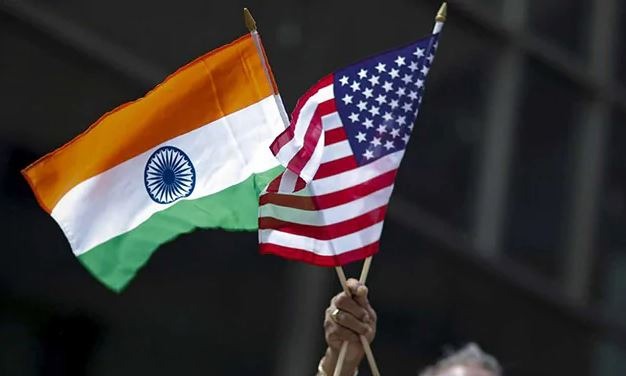
Washington: The 2+2 India-US ministerial in New Delhi next week would review the accomplishments and lay down the next steps for the global cooperation between the two largest democracies in the world, a senior Trump administration official has said.
The last major diplomatic engagement of the Trump administration days before the November 3 presidential election, the two-day meeting, involving four top cabinet ministers from India and the US, is expected to lay the foundation for the next four years of this relationship irrespective of who comes to power.
Speaking on the conditions of anonymity, senior administration officials from the State Department and the Pentagon asserted that there was a bipartisan support in the US on its relationship with India.
“The 2+2 ministerial will serve as a capstone to review our many accomplishments as well as lay down next steps for the US-India Comprehensive Global Strategic Partnership,” a senior administration official told reporters during a conference call organised by the Foreign Press Center in Washington DC.
Broadly, they intend to focus on four major themes at this year’s 2+2: global cooperation, which includes public health collaboration and work in the Indo-Pacific; economic cooperation, which includes partnership on energy and in space; people-to-people ties; and defense and security ties.
Noting that on the US-India economic cooperation, they are working together towards economic recovery and getting bilateral trade back on track, the official said the US International Development Finance Corporation has made commitments to support more than USD 500 million in investment projects in India and has recently assigned a managing director in Mumbai, who will help expand their investments in India and in the region.
The official said that joint efforts to develop and produce COVID-19 vaccines have taken off at a remarkable pace.
More than half a dozen American companies and institutions are working on vaccine research with Indian partners like the Serum Institute of India, the official said.
US Government’s health and development agencies, including the CDC, the National Institutes of Health, the Food and Drug Administration, and USAID, have provided technical assistance and training to Indian partners on a significant scale, including at the state and local levels.
Global cooperation also includes high-level engagements, the official said, adding that Secretary of State Mike Pompeo and External Affairs Minister S Jaishankar, along with their Japanese and Australian counterparts, met in Tokyo on October 6 for the second Quad meeting of foreign ministers.
“Given China”s increasingly aggressive behaviour across the Indo-Pacific from the Himalayas to the South China Sea, it”s more important than ever that we work with likeminded partners such as India,” said the official, adding that the US is also looking forward to working with India during its upcoming term on the UN Security Council to address these challenges and the other pressing issues before them.
Another senior administration official said that the defence relationship with India right now is currently at its best in recent memory.
“The progress we”ve made since India became a major defence partner in 2016 is remarkable. We held the inaugural 2+2 ministerial in 2018, Prime Minister Modi visited the United States in 2019, and President Trump visited India in February this year, just to name a few symbolic highlights,” said the official.
During the 2+2, the two countries are working to enhance maritime security across the Indian Ocean region by coordinating security cooperation and building partner capacity with regional countries.
India announced just this week that it was inviting Australia, which along with the US and Japan, to the Malabar naval exercise in November. The last time Australia participated in Malabar was in 2007, more than a decade ago.
“This invitation signals not only a strategic convergence between the Quadrilateral partners but a recognition that regional security requires strengthening allies and partnerships and working multilateral on issues of mutual concern,” said the official.
Noting that information sharing, which figures prominently in defence cooperation, the official said that the two countries have made significant progress towards concluding the last foundational defence enabling agreement, the Basic Exchange and Cooperation Agreement, or the BECA.
“This agreement will allow for expanded geospatial information sharing between our armed forces. We are also seeking to expand secure communication capabilities between our respective militaries as well as between our foreign and defense ministries, and that too figures prominently on what we”re trying to accomplish in the information-sharing space,” said the official.
With respect to military-to-military engagement, India and the US are working to build greater interoperability by increasing the sophistication of combined exercises.
The passing exercise between the Indian Navy and the U.S.S. Nimitz Carrier Strike Group this summer is just one example. The recent refuelling of one of Navy”s P-8 aircraft in Port Blair is another example, the official said.
Over the past year, the US has placed a liaison officer at the Information Fusion Center-Indian Ocean Region. And an Indian liaison was placed at US Central Command, which both of these have enhanced coordination and information sharing between the navies.
Follow this link to join our WhatsApp group: Join Now
Be Part of Quality Journalism |
Quality journalism takes a lot of time, money and hard work to produce and despite all the hardships we still do it. Our reporters and editors are working overtime in Kashmir and beyond to cover what you care about, break big stories, and expose injustices that can change lives. Today more people are reading Kashmir Observer than ever, but only a handful are paying while advertising revenues are falling fast. |
| ACT NOW |
| MONTHLY | Rs 100 | |
| YEARLY | Rs 1000 | |
| LIFETIME | Rs 10000 | |












